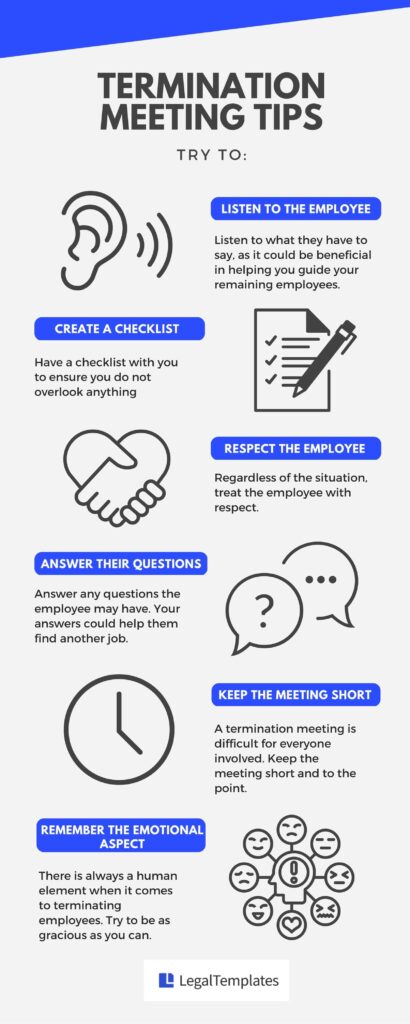No one wants to get fired, and no one wants to fire anyone. Unfortunately, there are situations where employees need to be let go, whether due to budget cuts or performance issues.
All situations of firing an employee need to be handled with care. Every scenario is different, particularly if you have an at-will employee who might not have a detailed employment contract.
Learn how to properly terminate an employee, and have an employment termination letter ready to expedite the process and protect yourself.

Determine the Termination Reason
There are several reasons why you might want to terminate an employee. You need a valid reason for terminating an employee, as you want to avoid any potential legal action.
There are many acceptable reasons why you might decide to terminate an employee, including:
- Poor quality of work
- Insubordination; refused to listen to their superiors or willfully disobeyed orders one too many times
- Repeated absences or being late
- Harassment or violence, regardless of whether it is physical violence, verbal abuse, or sexual harassment
- Theft or crimes during their time at the company
- Revealing trade secrets to the public or your competitors
All of these termination reasons can directly impact the revenue and profit generated by the company. Some of them could hurt your company culture, while others could directly threaten the health and safety of your employees, customers, and the company as a whole.
Do Your Research
Before terminating an employee, it’s crucial to conduct thorough research to ensure that your decision is legally sound and justified.
At-Will Termination
At-will employment allows an employer to dismiss an employee at any time, for any reason, and without prior notice, as long as the reason is legal. When an employee is hired “at will,” courts typically reject any claims for damages related to the dismissal.
Federal Termination Laws
Federal laws regulate certain aspects of employee termination to protect workers from unfair practices. Here are some key areas:
- Discrimination: Employers are prohibited from terminating employees based on protected characteristics such as race, gender, age, religion, disability, or national origin.
- Retaliation: It is illegal for employers to fire an employee as retaliation for engaging in legally protected activities, such as filing a complaint about workplace discrimination or participating in a workplace investigation.
- Breach of Contract: If an employment contract exists, employers must adhere to its terms. Terminating an employee in violation of a contract can lead to legal claims for breach of contract.
- Violation of Public Policy: Employers cannot dismiss employees for reasons that violate public policy, such as firing an employee for refusing to engage in illegal activities or for reporting illegal behavior.
Laws Governing Wrongful Termination
1. Title VII of the Civil Rights Act of 1964
- Prohibits: Discrimination based on race, color, religion, sex, and national origin.
- Coverage: Applies to employers with 15 or more employees.
2. Age Discrimination in Employment Act (ADEA)
- Prohibits: Discrimination against employees aged 40 and older.
- Coverage: Applies to employers with 20 or more employees.
3. Americans with Disabilities Act (ADA)
- Prohibits: Discrimination against qualified individuals with disabilities.
- Coverage: Applies to employers with 15 or more employees.
4. Family and Medical Leave Act (FMLA)
- Prohibits: Termination of employees for taking eligible leave for medical or family reasons.
- Coverage: Applies to employers with 50 or more employees.
5. Fair Labor Standards Act (FLSA)
- Establishes: Minimum wage, overtime pay, recordkeeping, and child labor standards.
- Coverage: Applies to most employers engaged in interstate commerce.
6. Occupational Safety and Health Act (OSHA)
- Prohibits: Retaliation against employees for reporting workplace safety concerns.
- Coverage: Applies to most private-sector employers.
7. Whistleblower Protection Laws
- Prohibits: Retaliation against employees who report illegal activities or violations of public policy.
- Coverage: Varies by specific federal or state whistleblower statutes.
8. National Labor Relations Act (NLRA)
- Prohibits: Termination for union activity or collective bargaining efforts.
- Coverage: Applies to most private-sector employers.
9. Worker Adjustment and Retraining Notification (WARN) Act
- Prohibits: Termination without 60 days’ notice in certain mass layoffs or plant closures.
- Coverage: Applies to employers with 100 or more employees.
10. State Wrongful Termination Laws
- Prohibits: Various forms of wrongful termination, including violation of public policy and breach of contracts.
- Coverage: Varies by state, with some states offering additional protections beyond federal laws.
Document Issues and Warnings
First, you must make sure that you document everything. There is a saying that if you don’t document it, it is like it never happened. You do not want to be accused of unfairly or inappropriately firing an employee, so you need to document evidence supporting your reasons for firing the employee.
For example, you might want to create a paper trail of mistakes, employee evaluation forms, issues, and past failures by the employee. Of course, you should also give the employee an opportunity to improve if they have not done anything to harm the company intentionally.
Prepare Termination Letter
When writing a termination letter, aim to be clear, brief, and compassionate. Here’s what you should include:
- Termination Date: Clearly state the date the termination will be effective.
- Reason for Dismissal: Briefly explain why the termination is occurring.
- Final Pay Details: Include information about the final paycheck and any outstanding compensation.
- Returning Company Property: Mention any company items that need to be returned.
- Benefits Information: Provide details on what happens to the employee’s benefits and who to contact for questions.
Inform the Employee in Person
You must schedule a meeting with the employee to terminate them in person. You need to think carefully about how this process will take place. Ideally, it should be done privately, but you might want a witness to sit in on the termination meeting and support your version of the events.
When the meeting takes place, be open and honest with the employee. State why the meeting is taking place, and inform the employee of why being fired. If the employee is owed a severance package (including unused vacation), explain the severance package and final paycheck in detail, and answer any questions the employee might have to the best of your ability.
If you feel it appropriate, thank the employee for his or her service and consider offering options or guidance for future career directions.
What to Say in a Termination Meeting
Because these meetings are so challenging, you might be interested in a sample ‘how to terminate an employee’ script. You can use a few options, and you may need to tweak these scripts to match your situation.
Remember that you may need to alter or change these scripts depending on your situation. That way, the employee understands exactly why they are being fired, and you can keep the meeting short, sweet, and to the point.
Terminating an Employee for Cause
“While we have given you plenty of opportunities to improve your performance, we continue to field complaints about your conduct from our clients and coworkers. Therefore, we’ve decided to terminate your employment here. Despite our checklists, advice, and supervision, you haven’t improved your performance, so today is your last day. We haven’t seen the necessary improvements, but thank you for your time at our company. If you have any questions, please ask us.”
Terminating an Employee At-Will
“John, today will be your last day at our company. We are severing your employment at will and will provide you with your COBRA notification and an explanation of how the process works. Thank you for your time and service to our company, but we have decided it is time to move on. We will need to collect all of our company property from your office. Please let us know if you have any questions.”

Use A Termination Checklist
A termination checklist helps ensure that all necessary steps are taken when an employee leaves the company. These should include returning company property, revocation of access to company systems, and processing of final paychecks and benefits.
Here are the key components of the checklist:
- Return of Company Property: Ensure that all company property, including electronics, keys, and credit cards, is returned.
- Revocation of Access: Immediately revoke access to company systems, including email, CRM tools, and internal communication platforms.
- Exit Interview: If possible, conduct an exit interview to gather feedback and address any remaining concerns.
- Final Paycheck and Benefits: Process the final paycheck, including any accrued vacation or severance pay, and provide information on benefits continuation, such as COBRA.
Mistakes to Avoid When Terminating an Employee
You can tailor the above steps to meet the needs of your specific situation, but there are also several common mistakes to avoid.
A few common mistakes that employees and managers make when they terminate an employee include:
- Firing without reason: If you are wondering how to terminate an employee without cause, outright firing them is probably not the best way to do so. If you fire an employee without a valid reason, you could set yourself up for a lawsuit for wrongful termination. Always make sure you have a valid reason if you want to fire or terminate an employee.
- Firing an employee without a witness: When you have a termination meeting with an employee, you must always ensure a witness is present. It might be that employee’s manager or a representative from the human resources department. Always have a witness present to avoid false accusations following the meeting.
- Firing without warning: Firing an employee is difficult for everyone involved in the process, but it is even harder when the employee does not see it coming. Always give an employee an opportunity to correct their job performance before you decide to fire them.
- Having a meeting that goes on too long: Firing an employee is emotionally draining for all parties, so try not to let the meeting go on too long. You need to keep the meeting short and sweet. Make sure you answer any questions the employee might have but try not to let the meeting go on too long.
- Giving the impression it is not permanent: Finally, you must ensure the employee understands that the firing is permanent. While you want to be nice, you want to be straightforward. Ensure the employee understands that they are not being suspended but are being terminated.
You may want to talk with your human resources team before it is time for the meeting. That way, you can make sure you avoid these mistakes and not set yourself up for possible legal action down the road.
Conclusion: Ensuring a Professional Termination Process
Terminating an employee is a challenging and sensitive task that should be handled with care to maintain professionalism and respect. Following best practices is essential for ensuring that the process is fair and transparent.
- Dignity and Respect: It’s crucial to treat the departing employee with dignity throughout the termination process. This includes providing clear reasons for the termination, offering support where possible, and conducting the conversation privately and respectfully.
- Clear Documentation: Keeping thorough documentation of the reasons for termination and the steps taken ensures that the process is legally sound and transparent.
- Compliance with Legal Standards: Adhering to federal and state laws regarding termination, such as avoiding discrimination or retaliation, is vital to prevent legal disputes and uphold ethical standards.
- Communicating with the Team: After the termination, it’s important to communicate with the remaining team members. This communication should be handled delicately, focusing on maintaining morale, addressing any concerns, and reinforcing the company’s values and expectations.
